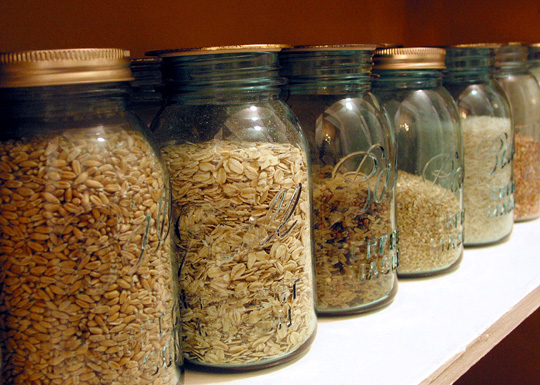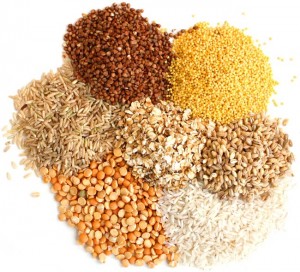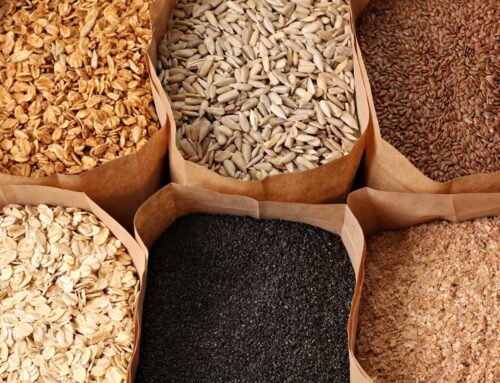Gaining popularity in the food industry is the use of the phrase, “whole grain,” especially in certain products such as baked goods, tortillas and cereals. But more than just a catch-phrase, the term actually has some deep-seeded meaning. While the term “grain” generally refers to the genera (Poaceae) and various species of the grass family, in this discussion we include both cereal grains and pseudo-grains (those seeds that resemble grains and can be eaten as grains, but which actually come from more broad-leaved plants).
 First, it is important to define the term “whole grain,” as it is globally defined by various food and agricultural organizations. For example, American, European, and Australian agricultural organizations, as well as the scientific community define whole grain as, consisting of the germ, endosperm, and bran in the same relative proportions as they are intact on the plant, with their inedible parts (such as the hull and husk) removed. In other words, the entire kernel or seed, minus the inedible hull and/or husk. The distinction, “same relative proportions” is a crucial characteristic, as the most nutritious parts of the grain reside in the germ, endosperm and bran; and removal of any proportion of any of those parts means that the grain is no longer considered whole. Removal of any parts of the grain thus causes the end product to lose some portion of its nutritional value. The same relative proportions phrase implies, too, that if the three main parts are separated during processing, they must later be reconstituted in the same proportions as they were when the kernel was intact, for the end product to be considered “whole grain”.
First, it is important to define the term “whole grain,” as it is globally defined by various food and agricultural organizations. For example, American, European, and Australian agricultural organizations, as well as the scientific community define whole grain as, consisting of the germ, endosperm, and bran in the same relative proportions as they are intact on the plant, with their inedible parts (such as the hull and husk) removed. In other words, the entire kernel or seed, minus the inedible hull and/or husk. The distinction, “same relative proportions” is a crucial characteristic, as the most nutritious parts of the grain reside in the germ, endosperm and bran; and removal of any proportion of any of those parts means that the grain is no longer considered whole. Removal of any parts of the grain thus causes the end product to lose some portion of its nutritional value. The same relative proportions phrase implies, too, that if the three main parts are separated during processing, they must later be reconstituted in the same proportions as they were when the kernel was intact, for the end product to be considered “whole grain”.
 According to the US Food and Drug Administration’s Standards of Identity, the following terms, often listed in ingredients, may also be considered as examples of whole grains: Cracked, crushed, whole-wheat flour, graham flour, bulger (cracked), groats, berries, entire-wheat flour, and bromated whole-wheat flour. Likewise, any time the word “whole” is mentioned before the grains’ name, such as “whole corn” and “whole oats,” the grain may be considered a whole grain. For rice (sweet brown, wild, etc.) they are generally always a whole product since the only part that is easily removable is the inedible hull.
According to the US Food and Drug Administration’s Standards of Identity, the following terms, often listed in ingredients, may also be considered as examples of whole grains: Cracked, crushed, whole-wheat flour, graham flour, bulger (cracked), groats, berries, entire-wheat flour, and bromated whole-wheat flour. Likewise, any time the word “whole” is mentioned before the grains’ name, such as “whole corn” and “whole oats,” the grain may be considered a whole grain. For rice (sweet brown, wild, etc.) they are generally always a whole product since the only part that is easily removable is the inedible hull.
What whole grains really mean for the consumer, is more complete nutrition from the grain. Commercial white (or refined) flours, of which wheat is the most popular, have a reputation for being the best medium for making pastries and other baked goods, yet lacking in nutritional value. Historically, this commodity gained popularity because the public demanded more white flours, which were developed by stripping the grains of their bran and germ, thus leaving the starchy endosperm. Countless nutritional studies have relayed that in wheat, for example, the bran and the germ contain the bulk of the nutrients. The germ has been shown to include most of the entire B-vitamin complex (except for vitamin B-12), rich amounts of vitamin E, high-quality proteins, unsaturated fats, minerals, and carbohydrates. The bran consists mostly of the insoluble carbohydrate cellulose (fiber), incomplete protein, traces of B-vitamins and minerals – especially iron. The endosperm, the largest part of the grain, contains mostly starch (a carbohydrate), incomplete protein, and trace amounts of vitamins and minerals.
Despite the mandated enrichment program of refined flours, they continue to lack necessary dietary fiber, and in essence are a ‘ghost’ of their former selves – delicious, nutrient-dense whole grains that add real substance to the human diet.
The following is a list of common whole grains and pseudo-grains; though it is not comprehensive, it does include many products that are widely available, worldwide:
[columns]
[column layout=”two”]
- Whole barley (hull-less)
- Whole-barley flour
- Whole-barley flakes
- Brown rice
- Brown rice flour
- Wild rice
- Whole corn
- Whole-corn flour
- Whole cornmeal
- Whole corn grits/polenta
- Oat groats
- Whole-oat flour
- Oatmeal, rolled oats
- Whole rye, rye berries
- Whole-rye flour
- Whole-rye flakes
- Teff
- Emmer
[/column]
[column layout=”two”]
- Whole wheat, wheat berries (all varieties)
- Bulger (cracked wheat)
- Crushed wheat
- Graham flour
- Sprouted wheat, sprouted wheat berries
- Stone-ground whole-wheat flour
- Whole-wheat flour
- Whole durum flour
- Whole-wheat flakes
- Kamut®
- Spelt
- Amaranth
- Buckwheat
- Millet
- Quinoa
- Sorghum
- Triticale
- Farro
[/column]
[/columns]
Written By: Sheila Cornwell
Quality Manager and Safety Coordinator
Bitterroot Tool & Machine, LLC
Sources:
www.healthgrain.org/webfm_send/253/1




